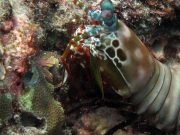Diving with Smashing Mantis Shrimp
Lanta Marine Life | Odontodactylidae
Smashing mantis shrimp are neither shrimp, nor mantis, they are a separate group of 450 species called stomapods. They are present at all our coral reefs, but not always easy to spot during Koh Lanta dive trips.
Sporting a thick shell that covers the back of the head and the first four segments of the main body, they are among the most efficient crustacean predators. Typically growing to around 10 - 15 cm in length, this group of animals have some of the most complex eyes in the world, including the ability to see polarised light.
Smashing mantis shrimp have two specialised calcified "smashing clubs" at the front of the body that are used to smash crab and clam shells at over 50mph in just a fraction of a second, and are known to crack and punch holes in aquarium glass.
Smashing Mantis Shrimp are solitary and territorial creatures, making burrows in hard seabed or coral cavities which are used as sites for mating and for keeping their eggs safe.
1 species found on this page:
Peacock Mantis Shrimp
(Odontodactylus scyllarus)
The Peacock Mantis Shrimp has an olive-tan to dark green body (the males are dark green). The antennae are yellow-orange to green. The eye stalks are pale bluish and the eyes are a greyish colour. The front side of the carapace (shell) is whitish with dark blotches. Further behind the head and body segments, the carapace is mottled tan to greenish to grey, with lighter blotches, spots and stripes.

Odontodactylus scyllarus @ Koh Haa
The Peacock Mantis Shrimp grows to 18 cm and has the most sophisticated vision and fastest strike of any predator on earth. The eyes work both together and independently to target prey and can detect more colours than any creature on earth, including polarised light.
The Peacock Mantis Shrimp is a Smashing Mantis, armed with two spring loaded hammer claws. The strike is up to 23 m per second (50 times faster than the blink of a human eye). When striking prey, for a moment, the surrounding water reaches the temperature of the surface of the sun (yes, really!).
The Peacock Mantis Shrimp builds its burrow in rocky and coral nooks and crannies and often hunts away from the burrow.
Diving with Smashing Mantis Shrimp around Koh Lanta
Scuba Diving & Snorkel Trips
If you'd love a chance to spot Smashing Mantis Shrimp on one of our daily high season diving trips from Koh Lanta then send us an email to info@diveandrelax.com.
Join our high season speedboat dive trips to some of Thailand's best dive sites and enjoy small groups, short journey times, with a focus on great personal service, safety and fun.
Not yet a certified diver? Learn to Scuba Dive on Koh Lanta with the 3 day SSI Open Water Diver course.
Book online to save 10% on dive trips and scuba courses on Koh Lanta.
Find Out More
Indo-Pacific Marine Life Guides
- Allen, G., Steene, R., Humann, P., DeLoach, N. (2003) Reef Fish Identification, Tropical Pacific. Jacksonville, FL., USA: New World Publications, Inc., ISBN 1-878348-36-1.
- Humann, P., DeLoach, N., (2010) Reef Creature Identification, Tropical Pacific. Jacksonville, FL., USA: New World Publications Inc., ISBN 978-1-878348-44-9
- Debelius, H. (2013) Indian Ocean Reef Guide. Frankfurt, Germany: IKAN - Unterwasserarchiv, ISBN 978-3-939767-52-7.
- Debelius, H. (2004) Nudibranchs and Sea Snails, Indo-Pacific Field Guide. Frankfurt, Germany: IKAN - Unterwasserarchiv, ISBN 3-925919-51-1
- Erhardt, H., Knop, D. (2015) Corals Indo-Pacific Field Guide. Frankfurt, Germany: IKAN - Unterwasserarchiv, ISBN 3-925919-69-4.
- Veron J.E.N., Stafford-Smith M.G., Turak E. and DeVantier L.M. (2016). Corals of the World


